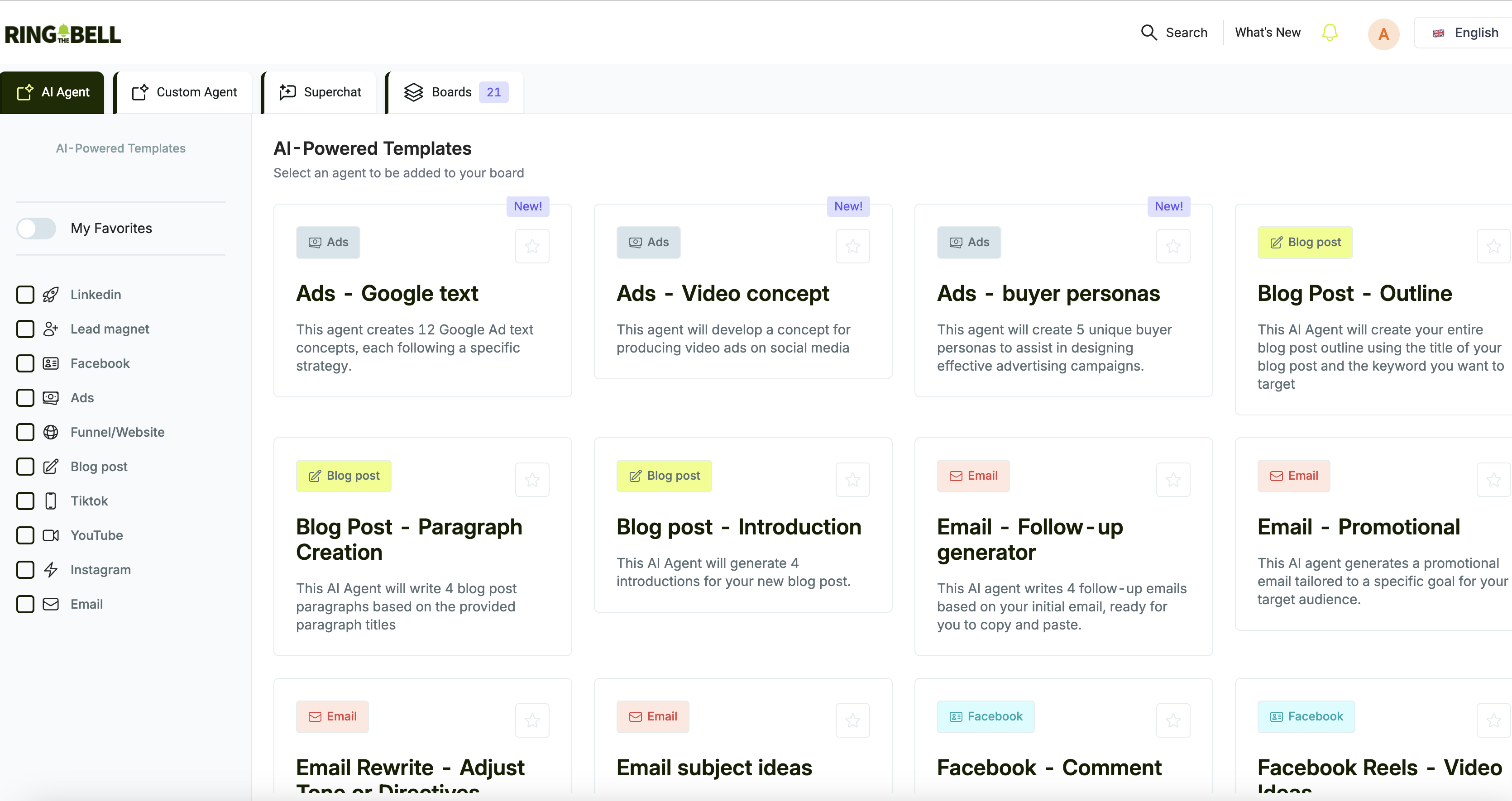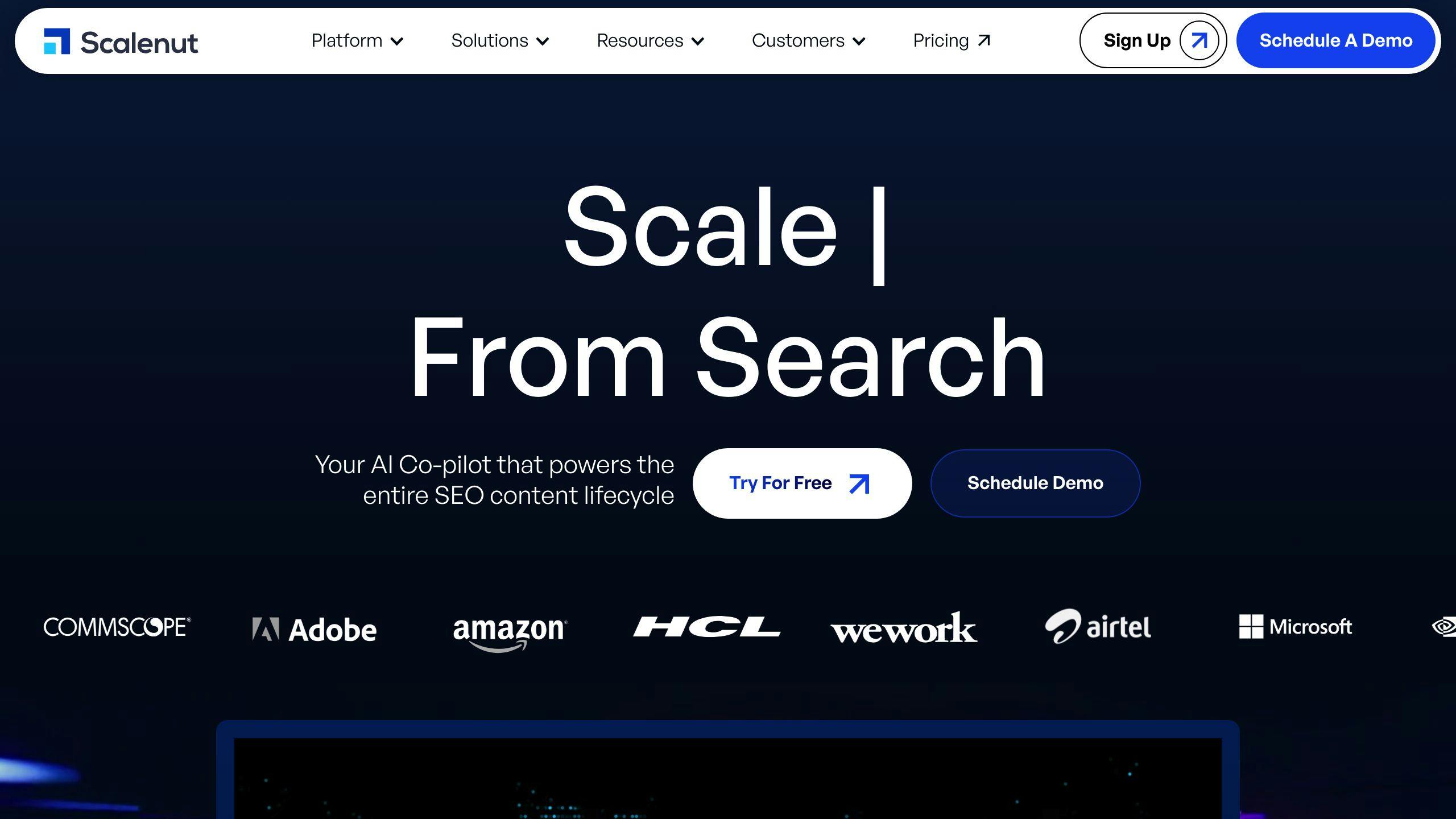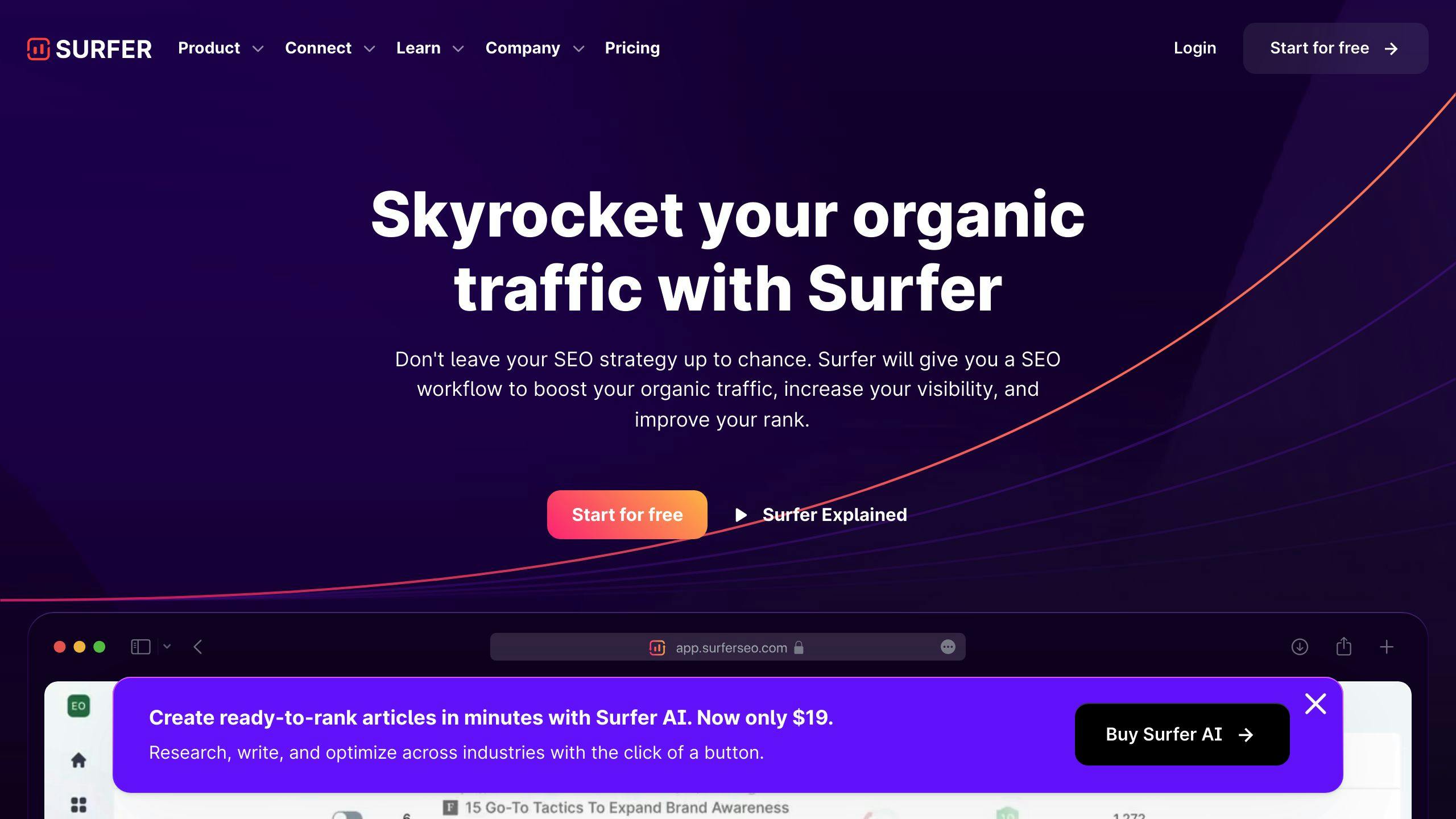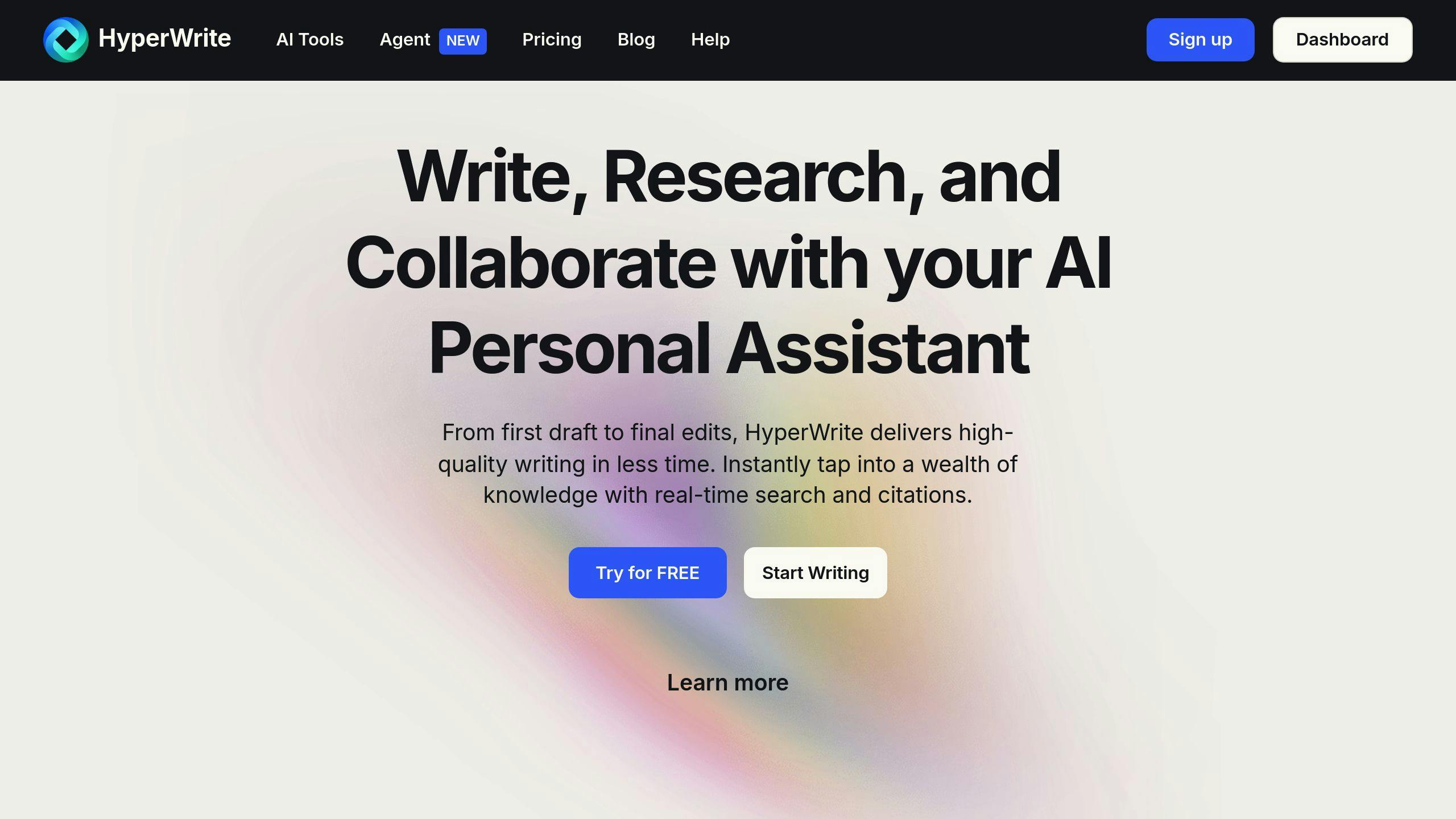AI tools can save marketers time and improve content quality by automating tasks like writing, SEO optimization, and personalization. Here’s a quick overview of 7 tools that can enhance your marketing efforts:
- RingTheBell: Combines AI content creation with workflow management. The ultimate solution to grow your audience and boost your online visibility!
- Jasper: Focuses on scaling content production with SEO-optimized drafts and integrations like WordPress. Offers “Boss Mode” for faster output.
- Scalenut: Merges content creation with SEO tools like keyword analysis and performance tracking.
- WriteSonic: Creates SEO-friendly content across formats like blogs and social media, starting at $19/month.
- Surfer: Specializes in content optimization with real-time SEO feedback and tools like SERP analysis.
- HyperWrite: Personalizes content using audience insights and adjusts tone for better engagement.
- Rytr: Affordable ($9/month) and multilingual, ideal for quick content creation across formats.
Quick Comparison
| Tool | Key Features | Best For | Starting Price |
|---|---|---|---|
| RingTheBell | AI + marketing workflow | Content marketing | Variable |
| Jasper | SEO-focused content generation | Scaling content production | Variable |
| Scalenut | Content + SEO integration | Data-driven content creation | Variable |
| WriteSonic | SEO-friendly diverse content types | Budget-friendly content | $19/month |
| Surfer | SEO optimization tools | Improving search rankings | $59/month |
| HyperWrite | Personalized content generation | Audience-specific content | Variable |
| Rytr | Multilingual, affordable AI | Quick, low-cost content | $9/month |
These tools help marketers streamline workflows, improve SEO, and create tailored content for better engagement. Choose one based on your goals, budget, and workflow needs.
The 7 Best AI Writing Tools Review (2025)
What Are AI Content Tools?
AI content tools leverage machine learning to streamline how content is created, optimized, and shared. They help marketers save time and connect better with their audience by analyzing data, generating ideas, and refining strategies.
These tools focus on three main tasks: automating repetitive work like drafting and editing, analyzing data to identify audience trends and preferences, and scaling personalized content to boost engagement and conversions.
What makes these tools so effective? Their ability to process massive datasets. For example, HubSpot uses AI to spot content opportunities by analyzing competitors and relevance [1]. This helps marketers craft content that truly connects with their audience.
Here’s a closer look at the core functions of AI content tools and the advantages they bring to businesses:
| Key Function | Description | Business Impact |
|---|---|---|
| Content Creation | Produces drafts, outlines, and briefs | Cuts production time by 50-70% |
| Data Analysis | Examines user behavior and performance | Supports smarter, data-driven decisions |
| Personalization | Customizes content for audience segments | Boosts conversions by up to 20% |
Companies like Netflix and Amazon use AI to personalize recommendations, which not only improves user engagement but also helps retain customers [4].
By transforming raw data into actionable insights, these tools empower marketers to create focused and effective content strategies. As eWeek highlights:
“AI-powered personalization delivers tailored experiences that enhance customer engagement, loyalty, and retention” [3].
Next, we’ll dive into seven AI tools that showcase these capabilities and help drive marketing success.
1. RingTheBell

RingTheBell merges AI-driven content creation with workflow management, giving marketers a powerful tool to simplify their content marketing tasks. It uses AI to generate a variety of content types, including:
- Blog posts and articles
- Email campaign copy
- Social media updates
- Sales funnel copy
What makes RingTheBell stand out is its built-in Kanban board system, which helps teams organize campaigns and manage content workflows with ease. Here’s a quick look at some of its key features:
| Feature | What It Does |
|---|---|
| Team Collaboration | Helps organize campaigns, assign tasks, and track progress. |
| Ai agent | Create and optimize all marketing content with Agent. |
| Stakeholder Access | Allows sharing progress via public board links. |
The platform also includes an analytics dashboard that tracks key metrics like audience engagement, content reach, and campaign effectiveness. These insights let teams fine-tune their strategies based on real-world data.
One of its best perks? RingTheBell offers a free plan with unlimited boards, team members, and tasks. This makes it a great option for teams of any size, removing financial barriers to trying out AI-powered content tools.
To get the most out of RingTheBell, marketers should pair its AI features with human input. This ensures the content stays true to the brand’s voice while maintaining a personal touch. Think of it as a productivity booster rather than a replacement for creative thinking.
While RingTheBell shines in combining content creation with workflow management, the next tool, Jasper, specializes in scaling content production.
2. Jasper

Jasper is an AI content generation tool designed to produce a variety of content types while keeping SEO in mind. Unlike RingTheBell, which emphasizes workflows, Jasper focuses on creating diverse formats that align with SEO practices.
The platform handles everything from blog posts and social media updates to product descriptions and email campaigns. Each piece is tailored to its specific channel and aligns with your brand’s voice and style, making it easier to scale personalized content.
Jasper integrates seamlessly with tools like WordPress and HubSpot, so teams can stick to their current workflows while using AI to speed up the content creation process. Its “Boss Mode” speeds up production by up to three times while keeping quality and brand consistency intact.
When it comes to SEO, Jasper offers real-time suggestions to improve keyword usage, structure, and readability. It also analyzes audience behavior to create content that resonates with specific demographics, increasing engagement and conversion rates.
The platform’s analytics dashboard helps teams fine-tune their strategy by tracking performance and making adjustments based on data insights. This mix of AI-driven content creation and performance tracking makes Jasper a powerful tool for content teams aiming to scale their efforts.
While Jasper shines in content creation and SEO, Scalenut takes a broader approach to automating content marketing.
3. Scalenut

Scalenut simplifies content creation by combining data insights with built-in SEO tools. It helps teams save time by analyzing trends, drafting content, and providing real-time SEO suggestions.
By merging content creation with actionable data, Scalenut eliminates much of the guesswork and speeds up marketing workflows. Its analytics tools continuously track performance, creating a feedback loop to refine strategies and improve future content.
For teams looking to expand their content efforts, Scalenut integrates seamlessly with popular content management systems and marketing tools. This allows teams to leverage AI for smoother workflows and better outcomes.
Here are some of its key SEO features:
| Feature | Purpose |
|---|---|
| Keyword Analysis | Finds trending topics and relevant keywords |
| Content Structure & Readability | Recommends proper headings and ensures content is easy to read |
| Performance Tracking | Tracks SEO rankings and engagement metrics |
What sets Scalenut apart is its ability to combine performance tracking with content creation. This ensures content is not only optimized for search engines but also engaging and meaningful for readers.
While Scalenut stands out for its focus on analytics-driven strategy, WriteSonic emphasizes flexibility in creating various types of content.
4. WriteSonic

WriteSonic is an AI-powered tool designed to help create SEO-friendly content for various needs, including blog posts, product descriptions, and social media updates. Its built-in SEO features analyze keywords, competitor content, and backlink data in real time, helping boost search rankings.
The tool works seamlessly with platforms like WordPress and Medium, making it easier for teams to manage their content workflows. WriteSonic also learns from user preferences, ensuring consistent and polished content across all channels.
How WriteSonic Supports Different Content Types
| Content Type | Benefits |
|---|---|
| Blog Posts | Optimized for search with targeted keywords. |
| Product Descriptions | Engaging, sales-focused copy. |
| Social Media Content | Tailored, attention-grabbing posts. |
| Landing Pages | Clear and persuasive calls to action. |
Pricing starts at $19/month, making it a budget-friendly option for businesses of all sizes. One standout feature is its ability to craft social media posts tailored to specific platforms, ensuring content fits the tone and format of each.
For the best results, teams should pair WriteSonic’s AI-generated drafts with human editing. This ensures the content feels natural while benefiting from the tool’s efficiency and SEO capabilities.
While WriteSonic provides a broad range of tools for content creation, the next tool, Surfer, focuses more deeply on refining content for search engine performance.
sbb-itb-3d9f177
5. Surfer

Surfer is an AI-powered tool designed specifically for content optimization with a strong focus on SEO. It combines data-driven insights with content creation tools, making it a go-to option for marketers aiming to improve search rankings while keeping content relevant and high-quality.
The Content Editor is a standout feature, offering real-time SEO feedback on aspects like keyword density, structure, and readability. This helps marketers tackle challenges such as boosting search visibility and simplifying SEO workflows – all without needing multiple tools.
Key Features and Uses
| Feature | Purpose | How It Helps |
|---|---|---|
| SERP Analyzer | Analyzes top-ranking pages | Guides content strategy |
| Content Planner | Creates data-driven briefs | Ensures thorough topic coverage |
| Keyword Research | Identifies useful keywords | Enhances targeting and reach |
| Content Score | Rates content optimization | Suggests improvements for SEO |
Surfer works seamlessly with platforms like WordPress and Google Docs, making it easy to optimize content directly within your workflow. Pricing starts at $59/month, positioning it as a solid choice for marketers serious about SEO.
How to Use Surfer Effectively
To get the best out of Surfer, focus on these practices:
- Keep your writing natural while following SEO recommendations.
- Balance keyword use with readability to engage readers.
- Leverage AI insights to shape your content strategy.
Surfer’s AI also analyzes competitors, offering up-to-date SEO advice to help create content that performs better. While it shines in SEO optimization, it takes a different approach than tools like HyperWrite, which are more focused on improving the writing process itself.
6. HyperWrite

HyperWrite is an AI-driven tool designed to simplify content creation while keeping it aligned with audience preferences. It helps marketers craft targeted content that connects with specific audience groups, all while staying true to the brand’s voice.
This tool combines personalization and efficiency, making it ideal for marketers looking to save time and boost audience engagement. By leveraging intelligent automation and insights, HyperWrite tackles common challenges in content marketing head-on.
Key Features and Applications
| Feature | Purpose | Benefit for Marketers |
|---|---|---|
| Content Drafting Across Formats | Generates drafts for blogs, social media, and more | Ensures consistent messaging across platforms |
| Audience Analysis | Identifies audience preferences | Helps create tailored, data-informed content |
| SEO Integration | Optimizes content for search engines | Boosts online visibility |
Personalization Capabilities
HyperWrite takes content marketing to the next level by:
- Suggesting topics based on audience behavior
- Adjusting tone and style to align with audience preferences
- Providing real-time tips to improve engagement
According to HubSpot, “86% of marketers say using AI saves them one or more hours a day by streamlining creative tasks” [2].
Practical Implementation
HyperWrite works best as a collaborative tool, combining AI’s speed and precision with human creativity to produce authentic content. It integrates seamlessly with platforms like WordPress and Google Docs, making it easy to fit into your current workflow.
“AI-powered personalization delivers tailored experiences that enhance customer engagement, loyalty, and retention.” – eWeek [3]
While HyperWrite shines in personalization, Rytr offers a cost-effective solution for marketers who prioritize quick and affordable content creation.
7. Rytr

Rytr is an AI-powered tool designed to make content creation easier and more efficient. It supports a variety of formats, including blog posts, social media updates, and product descriptions. With multilingual capabilities, it’s ideal for marketers running global campaigns. Plus, it integrates smoothly with platforms like HubSpot and Mailchimp, helping streamline your workflow.
Core Features and Applications
| Feature | Purpose | Marketing Advantage |
|---|---|---|
| Multi-Format Generation | Produces content for blogs, social media, and product descriptions | Ensures consistent messaging across platforms |
| Language Support | Handles multiple languages and styles | Expands reach for international campaigns |
| Integration Suite | Links with HubSpot, Mailchimp, and CMS platforms | Simplifies content management and distribution |
Rytr uses AI to analyze user data, creating content tailored to specific audiences. Whether you need engaging social media posts, persuasive product descriptions, or structured blog articles, Rytr helps maintain your brand’s voice and tone.
As noted in HubSpot’s 2022 report, “61% of marketers now rely on AI for content generation” [2].
Affordable and User-Friendly
Starting at just $9/month, Rytr offers a simple interface and dependable customer support, making it accessible even for those without technical expertise. Its dashboard includes easy-to-use templates and clear controls, making content creation straightforward.
Rytr’s combination of affordability and ease of use makes it a great option for marketers looking to explore AI-driven tools without a steep learning curve.
Choosing an AI Content Tool
When selecting an AI content tool, it’s important to find one that aligns with your marketing goals while maintaining your brand’s voice and content quality.
Key Factors to Consider
| Factor | What to Look For | Why It Matters |
|---|---|---|
| Integration Options | Compatibility with your current tools | Keeps workflows efficient and data connected |
| Scalability | Ability to grow alongside your business | Supports your future marketing goals |
| Content Quality | Accuracy and customization of AI output | Preserves brand messaging and tone |
| Pricing | Balance of cost and features, potential ROI | Makes the most of your marketing budget |
Evaluate Your Needs
Take a close look at your current process to identify where AI can make the biggest impact. For instance, if brainstorming content ideas is a bottleneck, tools like Jasper or Scalenut could be a great fit. On the other hand, if your focus is on refining and optimizing content, consider Surfer for its data-driven capabilities.
The Role of Data
Did you know that 61% of marketers already use AI for content creation? Personalization alone has been shown to increase engagement by 40% [2]. These numbers highlight the growing importance of AI in marketing strategies.
Balancing Budget with Growth
Look for a tool that fits your budget while also being able to scale as your needs grow. Premium options like Jasper offer a broad range of features, but if you’re just starting out or working with a smaller team, tools like Rytr can deliver great results at a lower cost.
Training and Support
Strong support is crucial, especially if your team is new to AI tools. Look for options with clear documentation, training resources, and active user communities. Tools like RingTheBell are particularly user-friendly, making them a solid choice for beginners.
Privacy and Security
Make sure the tool you choose complies with privacy regulations and protects your data – this is especially critical in regulated industries.
Wrapping Up
AI tools have reshaped how marketers approach their work. Tools like RingTheBell, Jasper, Scalenut, WriteSonic, Surfer, HyperWrite, and Rytr bring different strengths to the table, catering to various marketing tasks.
By automating routine tasks and offering data-backed insights, these tools allow marketers to focus on strategy and creative thinking. Personalization powered by AI has proven to boost engagement, especially in sectors like streaming and e-commerce.
The key is finding the right balance between AI-driven efficiency and human creativity. These tools are excellent for scaling content, tailoring user experiences, refining strategies, and simplifying workflows. Thoughtful integration of AI into your processes can enhance both productivity and creativity.
When adopting AI tools, start with clear goals and gradually incorporate them into your team’s workflow. For example, you might use RingTheBell for managing projects or Surfer to fine-tune your SEO efforts. The goal is to have these tools complement – not replace – your team’s creative efforts.
To make the most of AI, it’s crucial to understand its capabilities and limitations. Continuously track performance and adjust your strategies to get the best results. By combining the precision of AI with the originality of human creativity, marketers can achieve outstanding results while keeping their audience connections genuine.
FAQs
Here are answers to a few common questions about AI content tools and how they can help with marketing.
Which AI tool works best for marketing and content creation?
The right AI tool depends on what you’re trying to achieve. Different tools are designed to specialize in areas like:
- Content creation and copywriting
- SEO planning and optimization
- Maintaining brand consistency and team collaboration
- Social media content management
- Automating workflows
A study shows that 86% of marketers save at least one hour every day by using AI tools [2]. The trick is finding tools that address your main challenges and fit smoothly into your workflow.
What is an AI marketing tool?
AI marketing tools use machine learning to simplify and improve marketing tasks. These tools can help by:
- Analyzing customer behavior and trends
- Optimizing content to boost engagement
- Automating personalization for different audience segments
- Making workflows more efficient
Data reveals that 94% of marketers report higher sales when they use AI for personalization [2]. The best results come from blending AI’s capabilities with human creativity, ensuring you stay connected with your audience while working more efficiently.



